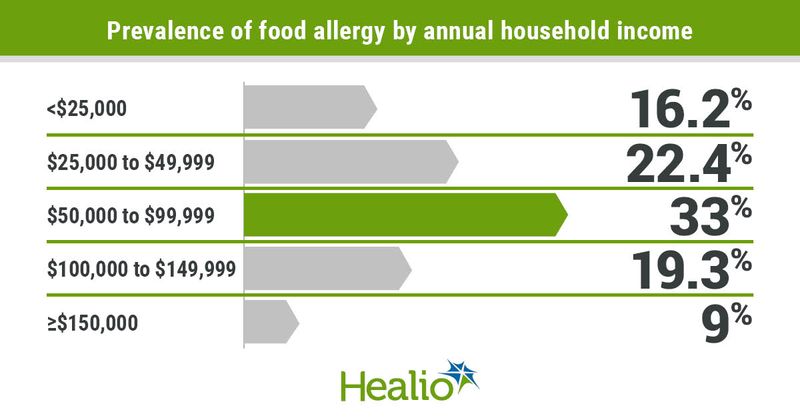Q&A: Community programs, policies could address food allergy disparities
Key takeaways:
- The FARE Community Access Program addresses unmet needs at the neighborhood level.
- Access to allergen-free foods is a challenge for many families.
- Research into interventions that relieve these burdens is needed.
Clinical outcomes in ED visits and epinephrine autoinjector use among other indicators have revealed racial, ethnic and socioeconomic differences in prevalence of food allergies among children and adults.
Published in JAMA Network Open, researchers found that rates of food allergy included 10.5% among Asian individuals, 10.6% among Hispanic individuals, 10.6% among Black individuals and 9.5% among white individuals.

Also, households earning more than $150,000 per year had the lowest prevalence of food allergy. Rates of severe food allergy reactions were highest among Black and Hispanic individuals as well.
Healio spoke with Anita Roach, MS, vice president of health equity and community engagement at Food Allergy Research and Education (FARE), to find out more about the real-world impacts of these disparities on patients with food allergy.
Healio: Do you think these findings are surprising or significant?
Roach: This study is significant. The study estimated the prevalence of food allergy in adults and children using a representative national sample inclusive of racial, ethnic and socioeconomic diversity. The researchers found that Asian, Black and Hispanic individuals and those with lower household incomes were more likely to report having a food allergy than white individuals.

Additionally, Black and Hispanic individuals reported higher rates of severe allergic reactions, allergies to multiple foods, and food allergy-related ED visits compared with other racial and ethnic groups.
These critical findings expand what we know about the racial, ethnic and socioeconomic differences in food allergy and can help stakeholders gather the resources, partners and support needed to create and measure sustainable change to mitigate and eliminate such disparities. These data help to expand efforts like the FARE Community Access Program, which seeks to address unmet needs at the neighborhood level in Black, Hispanic and other communities of color and in under-resourced, low-income areas.
By understanding and recognizing these disparities, stakeholders can partner on interventions that improve health outcomes and promote food allergy awareness to create a fairer and more inclusive health care system for all individuals.
Healio: How do these findings compare with your own experience?
Roach: These findings are comparable to what we see day-to-day. With the FARE Community Access Program needs assessment, we have found higher rates of food allergy in predominately Black communities such as the South Ward of Newark, New Jersey, compared with the general population. We also see more shellfish and finned fish allergy in these neighborhoods.
One of the most burdensome aspects of food allergy is accessing safe, healthy, allergy-friendly food substitutions, particularly for those with multiple food allergies, as well as awareness of and access to epinephrine to prevent potentially fatal anaphylaxis. Both food substitution and epinephrine education are areas of focus for our Community Access Program, given their role in preventing severe allergic reactions and improving quality of life.
Healio: How can doctors use these findings to improve care?
Roach: Previous studies by this group of researchers indicate that Black children may be less likely to be introduced to common allergens during the first year of life than white children. Given this latest study, it is imperative that all families, particularly those at higher risk and more burdened by food allergies, have access to information, tools and resources that make preventive strategies easier. As specialty care can be challenging for under-resourced populations to access, primary care and pediatric health care providers play a critical role in the diagnosis and management of food allergy.
Healio: How can these findings be used to improve policy?
Roach: These data strengthen the need for more policies related to food allergy education, access to nutritious foods and referrals to health care. For instance, 45% of all infants born in the United States are eligible for the Special Supplemental Nutrition Program for Women, Infants, and Children (WIC). Of those children, 37% are enrolled in Medicaid.
Providing peanut products in WIC infant food packages has the potential to reduce the risk for developing peanut allergy by as much as 80% based on prior research and would make early introduction of peanut more feasible for our most vulnerable families. Expanded substitutions in proposed revised food packages for children and women with existing food allergies would help make managing a food allergy easier, especially for those who live in food deserts.
Proposed legislation such as the recently introduced Protecting Children with Food Allergies Act, introduced by U.S. Senate Majority Whip Dick Durbin (D-IL) and Senator Tammy Duckworth (D-IL) and endorsed by FARE and other groups would require food allergy in nutrition education materials for WIC participants, which could improve access to vital food allergy management and early introduction prevention information.
Healio: What should the next step be in this research?
Roach: We need complementary research that helps us better understand which interventions are most effective at reducing disparities in food allergy prevalence and outcomes among Black, Brown and under-resourced populations.
